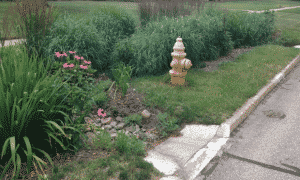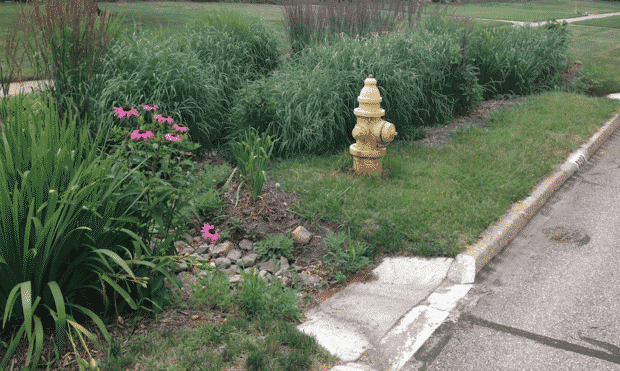Stormwater is water that used to soak into the ground and become ground water prior to development but runs off of impervious surfaces, collecting pollutants until it ultimately enters our surface waters. These pollutants include trash, chemicals, sediment, and oils among many others. Population growth and development rates are increasing the amount of pollutions and the volume and rate of runoff from impervious surfaces. Stormwater runoff pollution causes changes in hydrology and water quality that then result in habitat modifications, increased flooding, decreased aquatic biological diversity, and increased sedimentation and erosion. Best management practices (BMPs) like bioretention areas filter out pollutants and/or prevent pollution by controlling it at its source.
Bioretention areas capture and treat shallow amounts of stormwater runoff from impervious surfaces, like roads, parking lots, rooftops, etc. These concave areas are built using specific soil media, mulch, and vegetation. This soil media is composed of sand, pea gravel, and gravel. Stormwater runoff will be filtered and treated by traveling through the soil into the groundwater table or an underdrain pipe draining to local sewers or an appropriate outlet. Holden Arboretum has compiled a list of woody plants to be planted in bioretention areas and rain gardens that can be viewed by clicking here. These plants are able to survive both wet and dry weather, and their long roots help filter and treat stormwater.
Water Quality B enefits – Bioretention areas are able to reduce peak stormwater rates by providing runoff storage. In fact, post-development runoff rates in areas with bioretention cells are approximately equal to pre-development runoff rates. These areas are able to infiltrate up to 90% of annual rainfall, thus mitigating flooding impacts. Bioretention cells provide a number of water quality benefits by removing 95-98% of metals and reducing total nitrogen by 40%, nitrate-nitrogen by 15-75%, and phosphorus by 65%. Depending on the soil percolation rate, this treated water will either infiltrate into the groundwater or return to surface water via underdrain pipes.
enefits – Bioretention areas are able to reduce peak stormwater rates by providing runoff storage. In fact, post-development runoff rates in areas with bioretention cells are approximately equal to pre-development runoff rates. These areas are able to infiltrate up to 90% of annual rainfall, thus mitigating flooding impacts. Bioretention cells provide a number of water quality benefits by removing 95-98% of metals and reducing total nitrogen by 40%, nitrate-nitrogen by 15-75%, and phosphorus by 65%. Depending on the soil percolation rate, this treated water will either infiltrate into the groundwater or return to surface water via underdrain pipes.
Other Environmental Benefits – Bioretention areas help improve air quality in two ways. By treating stormwater through natural means, these areas help reduce emissions from water treatment plants. The plants within the bioretention c
ells also conduct carbon sequestration through photosynthesis, helping to purify our air. Bioretention cells can also serve as habitats for wildlife and increase ground water recharge.
Site Specifications – A number of criteria should be considered when selecting sites for bioretention areas. These cells cannot be built within a wetland or areas in which the ground water table reaches within four feet of the soil surface. The
selected site should include a designated water overflow area. If creating a bioretention area near a parking lot, the maximum water level of the bioretention cell must be 1-3 inches below the edge of the parking to prevent growth and build-up of debris acting like a dam. Bioretention cells should be 9-12 inches deep in a depressed area. The impermeable surface area should be 7.5 times the surface area of the bioretention cell for this specified depth. To prevent erosion, the water velocity must be kept below 1-2 fps at the bioretention cell inlets.
Plant Selection – As mentioned before, Holden Arboretum has provided a list of woody plants to be used in bioretention cells. You should choose plants relative to the type of soil on your site. Different types of soil have varying infiltration rates, and plants will grow differently in each condition. Avoid plants with aggressive roots that may infiltrate underground pipes in their search for air. Never plant cherry trees in a bioretention cell; when flooded, the roots release poison to kill the tree.
Cost – The cost of building a bioretention cell depends on the qualities of the soil at your site. In highly permeable soils (greater than 0.2 in/hr), the cost is estimated around $1.50-$3.00/ft2 because the runoff can be transferred to the ground water table after treatment. Slowly permeable soils (less than 0.2 in/hr) will require runoff to be transferred to surface water through pipes after treatment, and thus the cost is higher, around $4.00-$6.00/ft2. Yet preventing stormwater from entering combined sewer systems or requiring treatment has high avoidance costs, saving communities and residents money in the long run. Bioretention cells have also been estimated to increase rental rates by 7% and property values by 2-8%.

